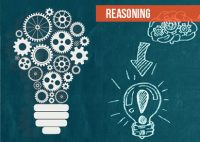Practice Important Reasoning Ability Questions for IBPS SO Prelims Exam 2017
Practice Important Reasoning Ability Questions for IBPS SO Prelims Exam 2017
Dear Bankersdaily Aspirant,
The IBPS SO Exam Prelims Exam is only 2 days away and you have to get prepared in an efficient way to crack the questions asked in the exam. We have been providing questions to solve to prepare efficiently for the IBPS SO Prelims Exam 2017.
You know that the pattern of the IBPS SO Prelims Exam 2017 have changed and as per the recent exam, the questions asked will be in a difficult way. So solve these questions and get prepared and ace your IBPS SO Prelims Exam 2017.
Today we are providing questions on Blood Relations. Solve and crack your exams in the forthcoming days.
D.1-2) Study the following information carefully and answer the questions.
A is the father of B and son in law of E. F is the niece of R who is mother of Z. R is the sister in law of H who is grandmother of B. H is not a parent of A.
Q.1) If Z is married to K and he is a banker then how is K related to R?
a) Brother in law
b) Sister in law
c) Son in law
d) Daughter in law
e) None of these
Q.2) How is H related to A?
a) Father in law
b) Mother in law
c) Son in law
d) Daughter in law
e) None of these
D.3-4) Study the following information and answer the given questions.
P and R are married couple. S is the only sister of R who is the child of T. K is the son in law of T. S is related to K in a same way P is related to R.
Q.3) How is R related to P?
a) Can’t be determined
b) Either c or d
c) Husband
d) Wife
e) None of these
Q.4) If Q is the son of R then how is S related to Q?
a) Paternal aunt
b) Maternal aunt
c) Niece
d) Nephew
e) None of these
Q.5) X, Y, S, T, R, M and Q live in a same family. X and Y are sisters of M and they are married to R and T respectively. T is the son in law of S. Q is daughter in law of S then how is Q related to Y?
a) Brother in law
b) Sister in law
c) Uncle
d) Aunt
e) None of these
D.6-10) In the following questions, the symbols @, *, ?, ! and # are used with the follow in; meanings as illustrated below:
`P @ Q’ means `P is son of Q’.
`P # Q’ means ‘Q is father of P’.
`P ? Q’ means `Q is daughter of P’.
`P ! Q’ means `P is mother of Q’.
`P * Q’ means `P is brother of Q’.
Q.6) How is W related to K where the following expression is definitely true?
J @ K ! T * W ? X # Z.
a) Sister
b) Daughter
c) Son
d) Brother
e) None of these
Q.7) How is Z related to T where the following expression is definitely true?
A * D ! Z ? P @ K * T.
a) Sister in law
b) Daughter in law
c) Son in law
d) Brother in law
e) None of these
Q.8) Which of the following statement is false where the following expression is definitely true R * W * K ? L # M@Q.
a) K is wife of M
b) R is brother in law of M
c) L is granddaughter of Q
d) M is mother of L
e) None of these
Q.9) In which of the following expressions shows that E is paternal aunt of C?
a) A!B?C#D@E
b) D#E*B@C?A
c) E!B@D@C?F
d) B*C#A@D?E
e) None of these
Q.10) Which of the following symbol should come in the place of _ in this expression ‘J@K_L_M*N#O*P’ that L is nephew of N and K is sister in law of N is definitely true?
a) @, @
b) *, *
c) !, @
d) @, !
e) None of these
You can check the answers for the above questions from the explanations that are given below.
You can check the other Important Reasoning Topics below here.
Important Seating Arrangement Questions For IBPS CLERK PRELIMS EXAM 2017
Important Puzzle Questions For Reasoning Ability Section For IBPS Clerk Prelims 2017



